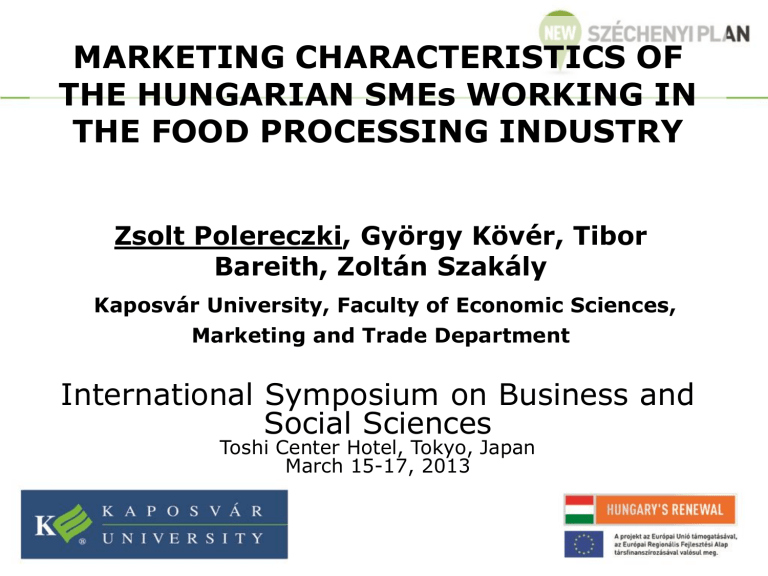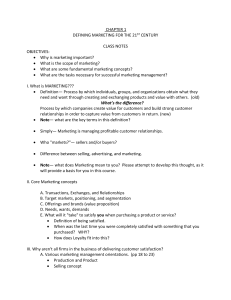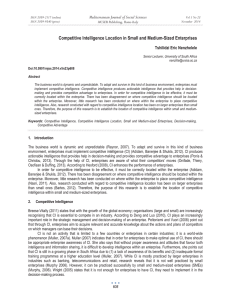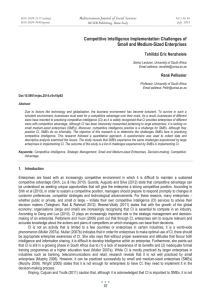1. dia
advertisement

MARKETING CHARACTERISTICS OF THE HUNGARIAN SMEs WORKING IN THE FOOD PROCESSING INDUSTRY Zsolt Polereczki, György Kövér, Tibor Bareith, Zoltán Szakály Kaposvár University, Faculty of Economic Sciences, Marketing and Trade Department International Symposium on Business and Social Sciences Toshi Center Hotel, Tokyo, Japan March 15-17, 2013 The structure of the presentation • Antecedents of the research • Aims of the research • Methodology • Main results • Consequences Antecedents the Is it possible toofset upresearch a branch related model relating to SMEs? • Basic idea based on the models explaining the consumers’ behaviour Consumers’ behaviour General models Product group related models Market orientation e.g.: EngelBlackwell-Miniard (1987); Howard, Sheth (1969) Desphande, Farley, Webster (1993); Kohli, Jaworsky (1990); Ruekert (1992); Kohli, Jaworsky (1990); Narver, Slater (1990); Shapiro (1988) e.g.: Shepherd, R. (1990); Pilgrim, F. J. (1957); Grunert, Brunso, Bisp (1993) Verhees, Meulenberg (2004) Aims of the research Model creation 3rd step International expansion of the research 2nd step In 2010 we investigated 250 agricultural and food industrial SMEs with internationally used standard questions – external and internal factors, market orientation, market efficiency 1st step Nationwide survey carried out in 2009 with 100 dairy and meat industrial SMEs - general entrepreneurial practice and opinion about marketing 1. 2. Testing MARKOR and MKTOR among food processing SMEs: Can the three-three factors in theManagerial two scalesfocus be considered one Cultural focus dimension? MKTOR Slater discriminating MARKOR - Kohli, Does each factor- Narver, have enough ability, that is do we Jaworsky (1990) have the right to(1990) separate the variables constituting the factors into three-three factors? Customer orientation Intelligence generation Competitor orientation Intelligence dissemination Interfunctional Responsiveness coordination Methodology • The composition of the sample Number employees of Composition Head % 0-9 people 136 71,2 10-49 people 42 21,9 50-300 people 13 6,9 Total 191 100 The data were analyzed with the structural equation modelling (SEM) method – Amos 7 (SPSS) Results • Acceptable one-dimensional models Nomination of factor Number of variables in the original model Number of kept variables Chi2 Degree of freedom p 6 4 9 10,430 4,790 37,049 7 2 26 0,166 0,930 0,074 8 5 4 5 3,542 - 2 0 0,170 - 4 4 0,248 1 0,618 MARKOR Intelligence generation Intelligence dissemination Responsiveness 10 8 14 MKTOR Consumer orientation Competitor orientation Interfunctional coordination • Summary of the discriminating ability investigation between the factor pairs Factor pairs Degree of freedom p 35,649 3 8,88E-08 141,02 1 1,59E-32 66,98 1 2,74E-16 Chi2 MARKOR Intelligence generation Intelligence dissemination Intelligence generation Responsiveness Intelligence dissemination Responsiveness The original model can partly be used MKTOR Consumer orientation 3,67E-20 in the case of SMEs84,592 working1 in the food Interfunctional coordination industry. • MARKOR scale, Intelligence generation factor – The food industrial SMEs collect secondary information through basically informal channels - enterprises consider this little information satisfactory, they are highly convinced that they react to real consumer demands (Responsiveness factor). • MARKOR scale, Intelligence dissemination factor – One of the weakest elements of market orientation is the effective information flow. • MKTOR scale, Customer orientation factor – Enterprises already feel commitment to customer orientation, however, it does not appeal in real activities. Consequences and implications • It is possible to decrease the onedimensional variables in a way that the refusal of the one-factor model cannot be justified in case of 5 of the examined six factors. The original model can not be used in the case of SMEs working in the food industry. Is it possible to set up a branch related model relating to SMEs? Yes! But new variables should be inserted in the model to increase its explanation ability. THANK YOU FOR YOUR ATTENTION! polereczki.zsolt@ke.hu








